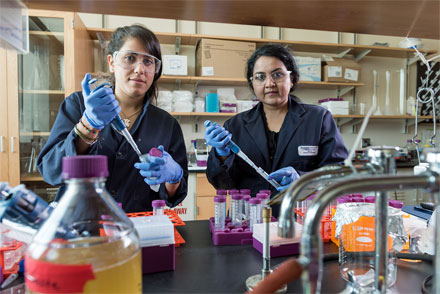Genetically encoded fluorescent sensors are providing a way to track the mobilization of labile heme (LH) in cells. The sensors offer significant insight into the nature and dynamics of this potentially dangerous nutrient of which there has been little understanding until now.
Although ratiometric fluorescent techniques for monitoring cell activity have been in use for a while, this is the first known technique that specifically senses heme. The heme sensors can be used across multiple organisms, including E. coli, yeast and human cell lines.

Osiris Martinez-Guzman and Bindu Chandrasekharan co-authored the study that tracked labile heme's movements in cells for the first known time. Courtesy of Rob Felt / Georgia Tech.
Researchers at Georgia Institute of Technology designed the ratiometric fluorescent sensor molecule by taking a heme binding protein from bacteria and clipping it onto fluorescent protein. They used a blue laser to charge the lamp portion of the sensor and deployed the sensor in the single cell yeast Saccharomyces cerevisiae. The sensor, nicknamed the “Green Lantern,” lit up bright green when heme was at very low baseline levels in the cell. An increase in heme concentration in the cell caused the light to fade out.
"You see this green image disappearing and reappearing depending on how much heme is available,” said assistant professor Amit Reddi. “You can see what's happening in real time."
Using the heme sensors, graduate student Osiris Martinez-Guzman found an enzyme, GAPDH, known for its involvement in breaking down sugar, that the team observed helping buffer cellular LH. When more LH was needed, the signaling molecule nitric oxide rapidly released heme from the proteins that were binding it.
“If you increase nitric oxide, you see the green glowing sensor dim as the heme becomes labile then the glow brightens back up over time as heme gets bound up again,” said Reddi.
By developing biosensors that can monitor heme in cells, the research team has discovered a new window into how cells make this essential toxin available in carefully sparse concentrations. Poor heme management may contribute to conditions such as Alzheimer's, heart disease and some types of cancers.
Many in science have held the belief that heme is basically static in hemoglobin and other cells, embedded and bound by proteins. But the use of fluorescent sensors to monitor heme activity has shown differently.
The research was funded by the National Science Foundation and National Institutes of Health, and was published in the National Academy of Sciences (doi: 10.1073/pnas.1523802113).
http://www.pnas.org/content/early/2016/05/26/1523802113.